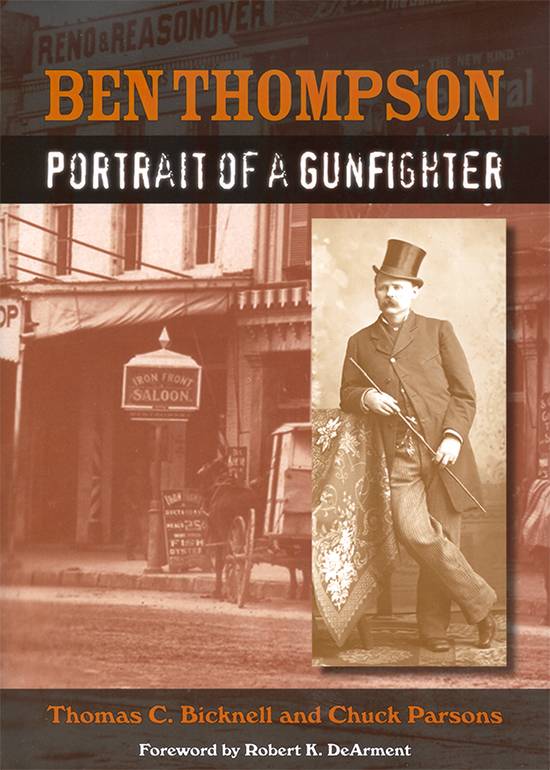Don’t Take Your Guns to Town

Ben Thompson: Portrait of a Gunfighter
by Thomas C. Bicknell and Chuck Parsons.
Denton: University of North Texas Press, 2018.
665 pp. $34.95 cloth.
Reviewed by
Joseph Fox
While films often mythologize the American West, a case can be made that the real historical figures from early Texas lived interesting enough lives with no dramatization necessary. Exhibit A: Ben Thompson, a Texas gunfighter who led a life surpassing most characters in Hollywood westerns, is the subject of the latest biography by historians Chuck Parsons and Thomas C. Bicknell. Thompson could best be described as a gentleman killer who made a living as a gambler. While loyal to friends and often honorable to enemies (always giving them the first shot in duels) he was also prone to reckless drinking, at times murderous rage, and deadly accuracy with a pistol. In their book Ben Thompson: Portrait of a Gunfighter, Parsons and Bicknell sort the contradictory accounts of Thompson’s life using a mountain of primary source material and sharp analysis to give the most complete portrait of a figure from early Texas who has mainly been forgotten in popular memory.
The authors tease the reader in the introduction of the book where they depict Thompson stepping into a San Antonio saloon called the Vaudeville in July of 1882 to confront the owner, an enemy named Jack Harris, who was armed with a shotgun. Leaving the outcome of the gunfight ambiguous, the authors restart in the first chapter to the beginning of Thompson’s life as a young immigrant from Knottingley, England, who moved with his family to the Austin, Texas, in the 1840s. It was growing up in the rough streets of a frontier town like Austin and then serving in the Confederate Army in Texas (as well as with Maximilian’s Imperialists in Mexico’s Civil War) in the 1860s shaped Thompson into a gambler and a gunfighter. While serving ably in several battles in Texas and Mexico, Thompson continuously gambled while off duty, which led to several gunfights and the deaths of several men who crossed him.
The bulk of the book focuses on the 1870s and 1880s where Thompson gained increasing notoriety and fame as a gambler and gunfighter. Despite being a killer, Thompson also was a family man, a saloon owner, the president of a Galveston firefighting company, and an elected City Marshall in Austin. Although he came out on top of his initial gunfight at the Vaudeville with Jack Harris in 1882, he returned to the Vaudeville in 1884 where friends of Harris shot Thompson in what was, as the authors effectively argue, a calculated ambush motivated by revenge. Controversial in life as in death, the shooting evoked debate between Austin and San Antonio newspapers, which feuded over the man’s legacy. Austin lamented the death of a local celebrity under suspicious circumstance while San Antonio newspapers described Harris as “avenged.” In what is an educational study of the nature of celebrity and the society that produces them, the authors chronical the contradictory headlines in an appendix in the back of the book which makes for an entertaining read.
Ultimately, the most impressive aspect of this book is the authors’ massive collection of primary source material with extra information to tell in almost every footnote. Both authors clearly have a passion for the history of America’s western frontier as they have already written extensively on the subject. Parsons has an impressive body of work including the Sutton-Taylor Feud and A Lawless Breed: John Wesley Hardin, and Bicknell has widely published in magazines and other publications about the Old West. Working together, they make a great case why Thompson’s contemporaries saw him as “a leading character in the Texas drama” in the first thirty years of the state’s existence. While noting what positive characteristics Thompson had, the authors offer a blunt assessment regarding his violence. Rather than mythologizing or whitewashing Thompson, Parsons and Bicknell offer a real story of America’s frontier, warts and all, that tops Hollywood cinema in terms of being an interesting and a must read for any Texan.
Joseph Fox is the Associate Education Officer at the Museum of South Texas History in Edinburg, Texas, and holds a Master of Arts in history from Texas State University in San Marcos, Texas. His areas of research include Borderland and Texas Music History. He has written articles for the Handbook of Texas History, a historical marker for the Texas Historical Commission. Mr. Fox’s Master’s thesis was on the relationship between Lone Star beer and the 1970s Austin music scene.
